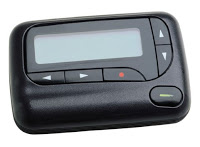 |
| Pager |
Pagers bridged the communication gap between the landline phones and cellphones until the evolution of mobile technology. Though vocal conversation was not possible via pagers (see image, left) yet the exchange of messages via text proved it an effective communication tool. The advent of mobile phones, however, wiped away the pagers from the communications world.
In its infancy, a system much like the pagers was introduced and used by the Detroit Police Department in the year 1921. After over two decades of improvement, the first telephonic pager was patented by Alfred J. Gross in 1949. Back then however, pagers were only used by people whose jobs required they be contactable at a moment’s notice. Some of the earliest people to get to use pagers were first responders and physicians.
It’s clear why the idea of pagers was attractive at the time. It was a system that allowed you to not only send messages in real time, but also receive replies or acknowledgements in return. And the fact that pagers are insanely easy to carry around only helped boost their popularity. Even today, a small fraction of the emergency services and police force uses pagers due to their reliability over regular cellular communication. It wasn’t until 1958 that the FCC approved the use of pagers by the civilian population.
Millions of restaurants across the USA adopted the use of pagers. The huge weekend rush of food lovers at restaurants would make it difficult for them to find a table to dine. Moreover, the long waiting period would not only make it tiresome but would also not give freedom to the customers to move around and utilize their time to run errands with the fear that in case they miss out on their number being called they would have to wait for another long period. The pagers would be distributed to each waiting customer and as soon as their turn would come, they would be communicated via the pager even if they were at a distance from the eatery, thus saving their time as well as maintaining the crowd systematically. At the end of the day, these pagers would be collectively recharged in a customized multiple charger to ready them to beep the next day.
Related posts:
